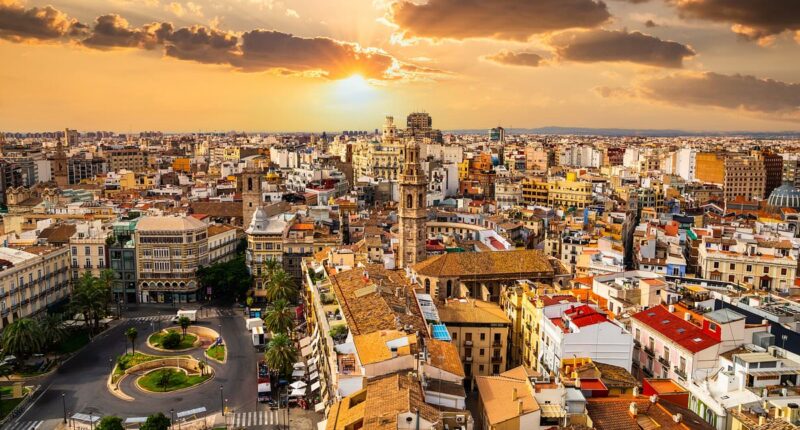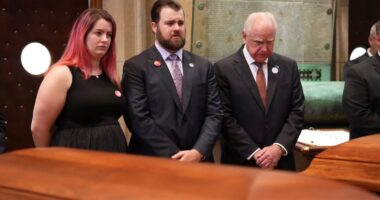A writer disclosed that he and his spouse are leaving California for Spain due to their discontent with the high cost of living and America’s fixation on automobiles.
Rocco Pendola, aged 49, who has resided in San Francisco and Los Angeles for the past 25 years, had previously mentioned that these cities are a representation of many positive aspects of America.
But he has now announced on his Substack personal finance blog that he and his wife will be permanently moving to Valencia next month.
The relocation to the third largest city in Spain has been in the works for months, with Pendola noting in January: ‘Upon deciding to move to Spain, my goal was to mark my 50th birthday there. If all goes according to plan and intention, I will commence the latter half of my life on foreign grounds.’
Numerous blog posts revealed that his decision boils down to the cost of living rising beyond what he believes is reasonable and how reliant the US is on cars.
‘I might be willing to keep paying a premium to live in [Los Angeles or San Francisco] if not for the perverse and never-ending influence of the automobile on the planet, our safety, and how we function and feel in our day-to-day surroundings,’ Pendola wrote in a piece published in SFGate.

Rocco Pendola (pictured) has been a freelance writer for decades and offered two reasons for why he’s moving in January from California toSpain

Pendola has spent the last 25 years in California, first living in San Francisco and then in Los Angeles (pictured)
Much of America’s car-centric culture stems from how leaders responded to the transportation needs of its citizens post-World War II when the country’s population and economy was booming.
With an interstate system that has 46,876 miles of road connecting the streets of nearly all cities, major and minor, Pendola thinks it’s clear: you need a car in America.
And that is his main problem with the country.
Pendola wrote that car dependency in the US has led to the ‘proliferation of not only suburbia but, in many cases, less dense urban cores.’
‘Some urban planning experts believe that San Francisco, Boston and Portland, Oregon, might as well be suburbs relative to their European counterparts,’ he added.
After World War II decimated nearly all of Europe and countries rebuilt themselves, those states have gone in a starkly different direction than the US when it comes to how people get around.
Between 10 and 20 percent of Western Europeans use public transit for their commutes, while only 2 percent of Americans do the same.

His move to Valencia (pictured) was spurred on by how reliant the United States is on cars and the high cost of living in most major US cities

Pictured: A section of the brand new National Interstate Highway System in the 1950s
Pendola also views the automobile as a menace to society, both in how they degrade urban residents’ lifestyles and kill thousands of pedestrians a year.
In a Substack post from last July, Pendola ranted about how ‘you limit yourself’ if you don’t drive in Los Angeles, where he currently lives.
‘You limit yourself when you don’t have a car because our public transportation system either doesn’t take you places where you want to go or takes you there using a route that’s so absurd you’d never even consider it,’ he wrote at the time. ‘Too much time. Too many transfers. Super inefficient and unpleasant.’
Pendola longs to live ‘a car-free lifestyle’ in a ‘built environment that not only encourages and facilitates, but pretty much necessitates walking, biking and taking public transit.’
In San Francisco, where he lived for seven years, he pointed out that there is a fight to close a single city block to cars so it can be pedestrianized.
Meanwhile, cities in Spain like Barcelona and Valencia are pursuing ‘superblock’ programs that often fashion as many as nine city blocks into a space conducive to people walking and biking.
Two blocks on Hayes Street in Hayes Valley, a neighborhood in San Francisco, became car-free on Fridays and weekends at the beginning of the COVID-19 pandemic.
Supporters include restaurants and businesses on the street that had access to a new clientele who were ambling into stores they might not have given a second look if they were zooming by in a car.

People walk the Hayes Street Promenade in San Francisco during the day

This section of road was first closed to cars on Fridays and weekends during the COVID-19 pandemic
Over the years, the street closures were gradually pared back. Now, only the 400 block of Hayes Street can remain closed and just on Fridays from 4pm to 10pm and Saturdays from 10am to 10pm.
The Hayes Valley Neighborhood Association, headed up Andrew Seigner, wanted to expand the closure back to three blocks.
Pendola spoke to Seigner, who said the overwhelming majority of businesses on the 400 block support closing it to cars permanently.
The opposition to this is led by a group called Hayes Valley Safe, which according to Seigner, is made up of a small handful of businesses that are not on the 400 block.
Pendola found it ironic that ‘safe’ is in their name, considering that they support letting cars to go through Hayes Street at all times when dozens of people die every year from vehicle crashes in San Francisco.
On what many call one of the deadliest streets in America, Lombard Street has had five deaths within 10 years, with two people killed this past year in the span of 10 days.
Signs were also placed at the intersections where pedestrians were killed, reading: ‘This is the site of a fatal traffic crash. Every year, around 30 people are killed and 600 people are severely injured in traffic crashes on San Francisco streets.
‘Arguing to keep a street safe by leaving it open to cars sounds odd, if not heartless,’ he argued.
Last month, the San Francisco Municipal Transportation Agency Board allowed the 400 block to close for another year but activists are continuing to fight for a permanent closure.

Lombard Street, which locals call the ‘deadliest’ street in the city, has a famous steep and winding road section

Walk San Francisco posted signs near pedestrians were killed along Lombard Street
Some businesses say ousting cars and pedestrianizing streets hurts their bottom line, but a study that examined pedestrian-friendly areas in Spanish cities disagreed.
Based on transaction data from a major Spanish bank, researchers found that ‘stores located in pedestrian environments tend to record higher sales volumes than stores located in non-pedestrian environments.’
The difference, Pendola says, between Barcelona and Valencia and a city like San Francisco, is that those two Spanish cities are pursuing infrastructure plans that benefit pedestrians citywide – not merely on a single city block.
‘I want to move to a place that gets stuff done because I’m drained by the piecemeal approach. Random projects throughout large cities that, even if successful, don’t change the prevailing lifestyle. The culture,’ Pendola wrote.
Barcelona began its superblock program in 2016 and built its first one in 2017. These superblocks don’t ban cars entirely, but they’re ‘often eliminated or calmed on the inner segments and directed to the outer avenues,’ Pendola said.
Engineers hope to build 503 superblocks by 2030, which would make ’60 percent of the streets previously used by cars would thereby be free for other uses,’ according to the city government of Barcelona.
Valencia, where Pendola is moving to in a few weeks, is pursuing similar plans as part of its 2030 Climate Mission.

An overhead view of Barcelona’s pedestrian-friendly superblocks. They’re bigger than normal city blocks but smaller than entire neighborhoods The city plans to build 503 of them by 2030

For Pendola, there’s a certain magic to Valencia and Spain as a whole that makes him want to call it home
But Spain is not just full of better designed cities in Pendola’s opinion. For him and his wife Melisse, urban areas there have an indescribable quality that makes them feel like home (even though he is of Italian heritage).
His wife ‘described this weird feeling of re-entering Spain from another country and feeling like she’s home. While I can’t quite put my finger on this feeling and why I also feel it, it’s palpable,’ Pendola wrote in a November Substack article.
Pendola’s Substack started out as a personal finance blog for people who believe they will never retire either out of necessity or by choice.
He advocates not banking on a traditional retirement strategy where you invest a portion of your income into a 401(K) and rely on measly Social Security payments.
The situation is bleak for three in ten Americans, who have nothing saved for retirement, let alone 13 times their current gross income that some financial planners recommend.
Barring an unrealistic scenario where a lucky stock pick makes you a millionaire, Pendola suggests people keep their costs low and find a career they can do into old age.
For Pendola, that’s writing. It’s what he’s been doing for more than 20 years and hopes to be able to do it for the rest of his life.
But the first part of the equation, keeping your costs low, fits perfectly with how Pendola’s blog has shifted in recent months to chronicle his move to Spain.
He believes moving to Spain will allow him to ‘never retire’ but still live comfortably – mainly because of the country’s lower cost of living.
Housing remains by far the largest annual expenditure for Americans at 32.9 percent.

Rent in Valencia, even on the pricier side, is more than 20 percent cheaper than the median apartment in Los Angeles

Valencia is pursuing similar pedestrian-centered plans as Barcelona as part of its 2030 Climate Mission
In Los Angeles, the median rent for a one-bedroom is $1,853 as of December, according to data compiled by Apartment List.
By comparison, one-bedroom apartments in the city center of Valencia range from 800 to 1400 euros per month ($845 to $1480), according to a ReValencia, a real estate company aimed at expats.
That’s 20 percent cheaper than the City of Stars.
For retirees, that should be a siren call. If two people retire at 67 years old – receiving full Social Security benefits – and both live until the average US life expectancy of 77 years old, the difference in how much they will pay is drastic between LA and Valencia.
Over the next 10 years, the Valencia retiree will have spent roughly $178,000 in rent, while the Los Angeles resident will have spent nearly $222,000.
Pendola also recently delved into how much groceries – the third biggest spending category for Americans – cost in Barcelona as opposed to Santa Monica.
While he was in Barcelona in February, he took a recent receipt he had from a Trader Joe’s in Santa Monica and bought all the exact same things at a Mercadona store in the heart of the city.
‘After making adjustments and running all of the math, the Trader Joe’s shopping trip cost $57.79, while – after making the currency adjustment – the Mercadona run would have cost $37.59, good for a $20 difference,’ Pendola wrote.
‘I’ll miss you California, but not that much,’ he signed off last week.

















